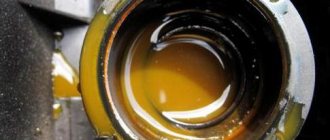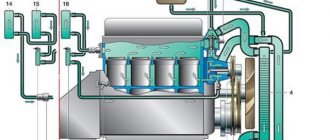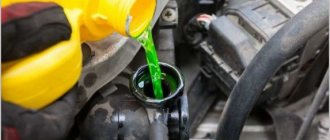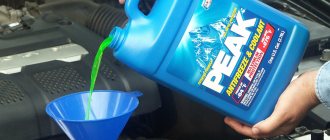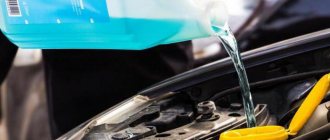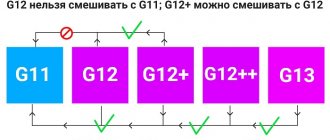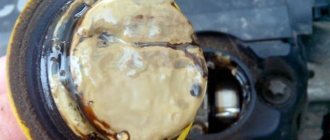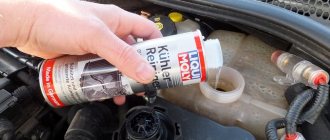The stable operation of a car engine largely depends on how the cooling system functions. At the same time, this fact escapes the attention of most novice car enthusiasts. Some people have no idea what is being put into such a system. Meanwhile, a reasonable choice of coolant is a guarantee of maintaining the “health” of your car.
The range of antifreezes and antifreezes is quite wide, but only in Russia there is an opinion that these are different types of liquids for cooling internal combustion engines. In fact, “Tosol” is the same antifreeze, but produced in our country. Although here we cannot talk about the complete identity of the compositions of these products. In this regard, we will try to determine which coolant is the best.
Characteristics
There are statistics based on the opinions of automotive experts that state that the causes of 20% of engine failures are directly related to the coolant. Another 44% of internal combustion engine breakdowns indirectly depend on the cooling system.
The composition of coolants is formed as follows:
- ethylene glycol compounds, which can sometimes be replaced by propylene glycol;
- additives;
- water.
It is the additives that differentiate antifreezes, to which “Tosol” should be included. With their help, corrosion processes are counteracted. The characteristics of the final product depend on the set and composition of additives. Otherwise everything is identical.
When buying this or that coolant for your car, you need to rely on the information written in the service book (instructions). With this document, the manufacturer tells you what coolant should be used and how to do it. Often, Western companies list certain brands of antifreeze that have undergone a full range of studies, which explains their suitability specifically for your car.
To better understand the differences between Tosol and antifreeze, let’s look at the technologies used in the production of these liquids:
- traditional - inorganic additives, for example, based on silicates and nitrates;
- carboxylate – organic additives, the creation of which uses carbonates;
- hybrid - a set of additives characterized as organic. There is a small presence of silicates, replaced or supplemented by phosphates.
The domestic product is produced using traditional technology, while the imported product is produced using carboxylate technology. In this regard, it is necessary to know the differences in the compositions obtained as a result of one or another technology in order to understand the pros and cons of different types of “coolers”.
Is it possible to mix antifreeze and antifreeze, what happens if you mix?
Both liquids - antifreeze and antifreeze are manufactured using different technologies, and they cannot be mixed . If the car was operated with antifreeze, and its owner decided to switch to antifreeze, before refilling, the cooling system is completely cleared of traces of old coolant.
When mixing antifreeze and antifreeze, a chemical reaction occurs between the additives, as a result of which some compounds coagulate and precipitate, which can clog the channels and ducts of the cooling system. This will lead to engine overheating and subsequent expensive repairs due to excessive oil consumption due to stuck piston rings.
Antifreezes have different compositions and are divided into mineral (class G11), organic (G12), and lobrid (G12++, G13). The difference between them lies in the additives:
- Antifreeze is classified as mineral antifreeze, which has a service life of 50 thousand km or 2 years of use.
- Organic ones can be used for up to 5 years or 250 thousand kilometers.
- Lobrid fluids can be combined with any other cooling fluids and added to new engines without fear.
Advantages and disadvantages
A positive aspect of traditional technology is the protection of metal surfaces from corrosive processes. The use of "Antifreeze" leads to the formation of a protective film on the parts of the power unit, the thickness of which can reach up to 0.5 mm.
Corrosion resistance is an excellent factor, but such a film has insufficient thermal conductivity. This causes the cooling efficiency of the internal combustion engine to be reduced by half. In this regard, “Tosol” should be recognized as an insulator. The power unit begins to overheat regularly, without reaching critical temperature values. Although this still does not have the best effect on the performance of the engine. Its operation in unacceptable conditions from the point of view of proper operation leads to rapid wear, loss of power and increased fuel consumption.
This type of problem does not exist when using carboxylate liquids, which should be understood as antifreeze. Their use also contributes to the formation of a protective layer, but of a much smaller thickness - 0.0006 mm. Such a thin film does not interfere with the normal removal of heat from engine parts, which prevents overheating.
The silicates present in “Tosol” can become gel-like, and the phosphates included in the “cooler” precipitate, which is associated with the processes of cyclic heating and cooling. All this together leads to the formation of a mixture that makes the normal functioning of the radiator impossible. This device becomes clogged and the cooling system loses its functionality. In this regard, carboxylate compositions are preferable, since they are free from such disadvantages.
As a result, we can recognize the clear leadership of antifreeze in terms of ensuring complete cooling of the internal combustion engine, if not for some nuances. There are still a sufficient number of characteristics that influence this process.
Compatibility of "Tosol" and antifreeze
You can often hear a question about whether it is possible to add Antifreeze to antifreeze and vice versa. The above information already gives the answer to this question, which is negative.
You cannot mix not only domestic and imported products of the type in question, but also mixtures from the same manufacturer that differ in color. If you decide to change the coolant, you should flush the engine using distilled water. The receiver is filled with new engine cooling agent when absolutely clean liquid flows from the system.
Attention! When mixing formulations produced by different manufacturers, ensure consistency in color. If the color matches, then we can talk about their compatibility.
Antifreeze and antifreeze: what is the difference?
Antifreeze is a coolant containing salts of inorganic acids as corrosion inhibitor additives:
- nitrites;
- nitrates;
- silicates;
- borates;
- amines;
- phosphates.
The technology for producing antifreeze is considered outdated; such coolants are not produced in developed countries.
A more progressive development is antifreeze: it is a coolant whose additive complex is formed by salts of organic acids, collectively called “carbonates”. It is precisely because additives belong to this group that antifreezes are often called carboxylate coolants.
In addition to these differences, there is one more thing that even a novice car enthusiast will immediately point out. The point is that antifreezes and antifreezes produced by different brands have different colors. Many, in bewilderment, ask the question: what, for example, is the difference between blue antifreeze and red, and what is the difference between green antifreeze and blue?
We declare with full responsibility: the color of the coolant does not in any way affect its performance characteristics and is not worth your attention. It is the result of the addition of a dye, which coolant manufacturers try to distinguish their products from all others. Of course, red antifreeze is different from green, but the difference lies not in the appearance of the liquid, but in its performance characteristics.
Term of use
“Antifreeze” is mainly silicates and nitrites, which serve as the substances on the basis of which additives are created. Silicates provide protection for aluminum, and nitrites guarantee resistance to cavitation erosion. In the latter case, we mean a destruction process triggered by steam bubbles, the collapse of which leads to hydraulic shocks.
Hydraulic cavitation becomes one of the causes of liquid pump failure. The formation of cavities contributes to the destruction of the metal, which ultimately renders the part unusable. Manufacturers' advertising campaigns convince that antifreeze provides protection against this phenomenon, but this is a far-fetched fact. Antifreeze has no advantages over Antifreeze. Although the domestic product has a slight advantage over its foreign counterpart, since it forms a film, the thickness of which saves cylinder liners from high-temperature cavitation.
Coolants have balanced compositions. In this case, situations are possible when greater consumption of one or another component occurs. This reduces the properties of “Antifreeze”, which ceases to effectively protect the internal combustion engine from overheating and corrosion. Critical temperatures and some other factors contribute to the precipitation of silicates and nitrites, which occurs after the car has traveled 30–35 thousand km. By this time, the “cooler” almost completely ceases to perform its functionality.
As for coolants, in the manufacture of which organic salts are used, their properties are maintained throughout the entire allotted service life. Their composition remains homogeneous, additives precipitate in a minimal amount. Antifreezes produced abroad are designed for operation for 2 years with a car mileage of 100 thousand km.
Attention! Replacing antifreeze or antifreeze must be done on time. You should not wait until the coolant has completely exhausted its service life.
What is the difference between antifreeze and antifreeze?
Both products are coolants that are poured into the engine cooling system in order for it to function properly at any temperature. The main property of such liquids is that their freezing point is much lower than that of water. But they also have differences that will be useful to know about.
Kinds
Antifreeze is the general name for any coolant, regardless of time and place of release.
Antifreeze is an analogue, only released in the USSR. In those days, there was no replacement for it, so the name of the brand became a household word and antifreeze was used to call any coolant, both domestic and foreign. In general, TOSOL is an abbreviation for “technology of organic synthesis of a separate laboratory.”
These types of antifreeze are used in the automotive industry:
- G Hybrid species, green in color. Provides protection against corrosion, maintains the integrity of the system pipes, enveloping the walls with a protective film. Suitable for passenger cars and aluminum parts;
- G Organic red product. A protective film is formed only in those places where rust has appeared. Suitable for truck engines. Extends the service life of brass and copper parts;
- G The most environmentally friendly product, orange in color. It is used to cool car and motorcycle engines.
Antifreeze, like antifreeze, also comes in several types:
- A – ready-to-use product;
- M – modernized, with additional components;
- K is a concentrate from which you make your own coolant.
After the letter designation there are numbers - this is the freezing temperature of the coolant. In this case, the name can be anything. For example, "Neva". Antifreeze is intended for cooling systems of domestic cars.
Characteristics and properties
Due to inorganic salts, the radiator may become clogged over time.
Antifreeze forms a protective film on the surface of metal parts, no more than 0.5 mm thick. But such protection has low heat transfer, which leads to increased fuel consumption and rapid engine wear.
It contains inorganic salts, which can cause the radiator to become clogged over time. The maximum operating temperature of antifreeze, until which its properties are maintained, is +105 degrees Celsius.
Antifreeze is a coolant that forms a protective layer only in those places that are susceptible to corrosion. Since the rest of the metal is not coated with anything, this does not interfere with heat transfer.
The composition contains organic salts, so no sediment is formed during operation. The boiling point is +115 degrees. The color of antifreeze does not matter - it is a dye that does not affect the capabilities of the liquid.
Compound
The basis for the production of antifreeze is ethylene glycol, glycerin, triethylene glycol or a mixture of them. The final composition depends on the manufacturer, but it also includes water, dyes and corrosion inhibitors. Additives – salts of inorganic acids (phosphates, silicates, nitrates, nitrites).
Letter designation G12
The basis of antifreeze is similar antifreeze agents, only organic additives are used. Modern liquid (“Lobrid”, with the letter designation G12++) is made on the basis of propylene glycol, as a more environmentally friendly substance.
The difference between coolants is the value of the additives.
Organic ones are better, as they have a beneficial effect on anti-cavitation, anti-corrosion and anti-foam properties.
Areas of use
Marked G12+
There are many different “anti-freeze” products available, therefore, choosing a fluid for a car of any brand, domestic or foreign, is not a difficult task.
As for antifreeze:
- G A product similar to antifreeze, suitable for cars manufactured before 1996. Not suitable for modern cars, as it worsens engine cooling;
- G Choice for high-speed, heat-loaded transport;
- G12+. For modern cars;
- G For high-performance engines (sports cars, motorcycles) operating under maximum loads.
Manufacturers of antifreeze fluids do not recommend using antifreeze due to the fact that it contains inorganic additives that affect engine performance.
Therefore, this coolant is chosen by those who drive old cars, usually domestic ones, where there is no point in caring for an already “tired” engine.
Life time
Antifreeze is a mineral “antifreeze” that can last 50,000 km (2 years). Organic antifreeze lasts longer - 250,000 km (5 years).
The passport for the liquid indicates how long you can drive on it. But, if the product has changed color or is completely discolored, it means that its protective properties have been lost and it’s time to replace it.
An unpleasant odor says the same thing. During the replacement, before pouring new fluid into the tank, the cooling system is washed with special products and water.
Impact on different materials
Aluminum is becoming an increasingly popular metal in the automotive industry. Even power units are produced on the basis of its alloys. This state of affairs is somewhat problematic in terms of the use of cooling liquids. They do not protect aluminum well from destruction when loads increase and temperatures reach high values.
When reached, it completely loses its protective characteristics in relation to aluminum. It is this feature that has led leading car manufacturers to abandon the use of this type of cooler.
Carboxylate compounds demonstrate completely different properties. Dynamic corrosion testing revealed the high efficiency of antifreeze. With their help, it is possible to increase the service life of the machine by 45–60%.
Plastic, rubber and silicone are materials that are actively used in the creation of cooling systems. From the side of carboxylate compounds, no negative effects were recorded in relation to these materials. However, “Antifreeze”, if it is of high quality, also does not have a destructive effect on them.
How to distinguish "Tosol" from antifreeze
Distinguishing coolants from each other is not only problematic, but almost impossible. This explains why you can always run into a fake.
Important! You can avoid buying a counterfeit product if you purchase it exclusively in specialized stores. This will not give a 100% guarantee, but it will reduce possible risks to a minimum.
At the same time, some “knowledgeable people” dispute the above statement. They state that the types of coolants mentioned differ from each other:
- taste - a large amount of ethylene glycol present in Tosol makes the composition sweetish. If you wish, you can conduct a taste experiment, although this is undesirable due to the toxicity of this liquid;
- consistency - “Antifreeze” is more reminiscent of vegetable oil in its physical state, and antifreeze is more like plain water.
The color of the coolers is not an indicator, since it depends on the dyes used.
Is it possible to mix liquids?
Antifreeze, regardless of its shade, can only be mixed with distilled water. It is prohibited to mix one brand of coolant with another, even if they are almost the same in color. Remember that all brands have different amounts and proportions of additives, so it is unknown how one type will react to another. The most unpredictable reactions are possible, and if you value your car, you will never expose it to such danger.
In cases where the required proportions are forgotten when diluting antifreeze with water, you can use an aerometer, a device that shows the density of the coolant.
Before you start using coolant, study this issue based on the accompanying documentation for your car, which describes in detail all possible options for using a particular chemical.
Each series of cars has different types of radiators and engines; here you need to approach it strictly individually. One type of antifreeze is suitable for copper radiators, and another for aluminum ones. You should not focus solely on the color of the product, since its chemical composition may differ sharply from that recommended by the car manufacturer.
Conclusion
An analysis of the properties of Tosol and antifreeze is not in favor of the domestic product. Although, if you operate an old car equipped with a cast iron engine, then it is better to give preference to Tosol. Our “cooler” is cheaper and completely safe, since it does not cause any harm to this type of metal. If the car is more modern, then it is advisable to choose antifreeze, since the technologies used in the automotive industry today are the use of aluminum alloys, plastic, silicone, rubber and similar materials.
Antifreeze - what is it?
Antifreeze is a type of antifreeze made in the USSR. Antifreeze is a coolant for an internal combustion engine.
Previously, water was used to cool the engine in Soviet cars. But in winter it froze, which could lead to serious damage, as well as a crack in the block.
Drivers had to drain the water in the evening and fill it again in the morning. This was completely inconvenient, so they set the task of creating a coolant resistant to frost. This is how antifreeze was invented.
There is a similar article on this topic - How to choose coolant for a car?
It consists of water, with the addition of ethylene glycol and various additives from inorganic salts. This allows the antifreeze to not freeze at low temperatures.
The minimum operating temperature varies and is indicated in the brand of antifreeze, for example, Antifreeze-40 can be used at a temperature not exceeding -40°C.
Antifreeze also has its drawbacks . The fact is that this liquid is aggressive, that is, during operation it affects the elements of the cooling system, destroying them.
To avoid this, various additives are used. They create a special protective layer on engine elements, which avoids corrosion of parts. But this layer prevents normal heat exchange between the antifreeze and the block, and cooling is its main task.
Another disadvantage of antifreeze is its short service life. Usually it is about 40 thousand kilometers, after which the coolant must be changed.
